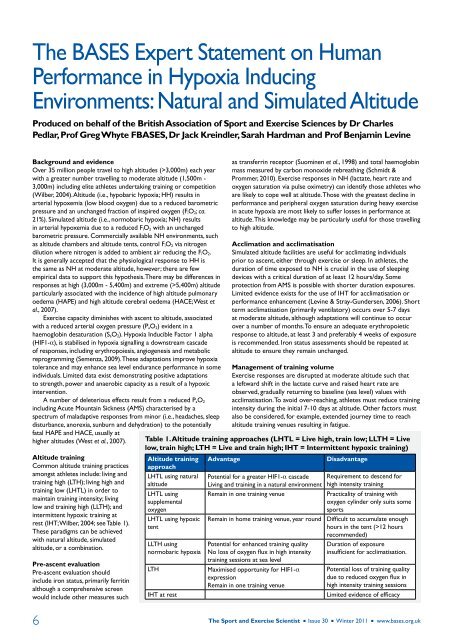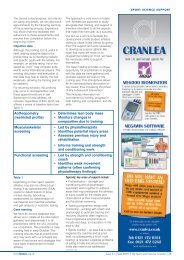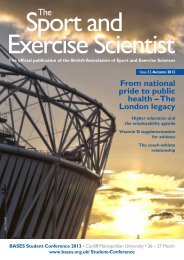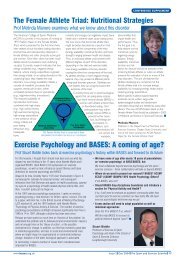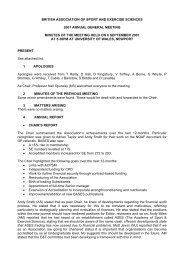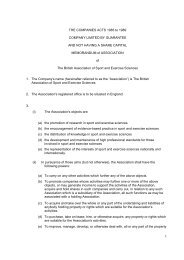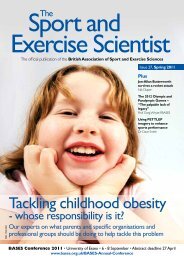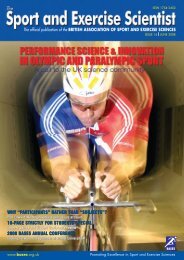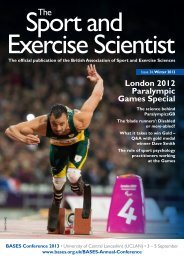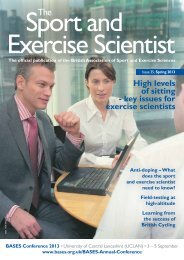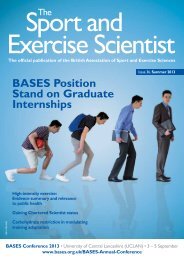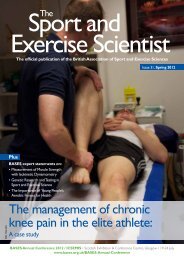The BASES Expert Statement on Human Performance in Hypoxia ...
The BASES Expert Statement on Human Performance in Hypoxia ...
The BASES Expert Statement on Human Performance in Hypoxia ...
You also want an ePaper? Increase the reach of your titles
YUMPU automatically turns print PDFs into web optimized ePapers that Google loves.
<str<strong>on</strong>g>The</str<strong>on</strong>g> <str<strong>on</strong>g>BASES</str<strong>on</strong>g> <str<strong>on</strong>g>Expert</str<strong>on</strong>g> <str<strong>on</strong>g>Statement</str<strong>on</strong>g> <strong>on</strong> <strong>Human</strong><br />
<strong>Performance</strong> <strong>in</strong> <strong>Hypoxia</strong> Induc<strong>in</strong>g<br />
Envir<strong>on</strong>ments: Natural and Simulated Altitude<br />
Produced <strong>on</strong> behalf of the British Associati<strong>on</strong> of Sport and Exercise Sciences by Dr Charles<br />
Pedlar, Prof Greg Whyte F<str<strong>on</strong>g>BASES</str<strong>on</strong>g>, Dr Jack Kre<strong>in</strong>dler, Sarah Hardman and Prof Benjam<strong>in</strong> Lev<strong>in</strong>e<br />
Background and evidence<br />
Over 35 milli<strong>on</strong> people travel to high altitudes (>3,000m) each year<br />
with a greater number travell<strong>in</strong>g to moderate altitude (1,500m -<br />
3,000m) <strong>in</strong>clud<strong>in</strong>g elite athletes undertak<strong>in</strong>g tra<strong>in</strong><strong>in</strong>g or competiti<strong>on</strong><br />
(Wilber, 2004). Altitude (i.e., hypobaric hypoxia; HH) results <strong>in</strong><br />
arterial hypoxemia (low blood oxygen) due to a reduced barometric<br />
pressure and an unchanged fracti<strong>on</strong> of <strong>in</strong>spired oxygen (F iO 2; ca.<br />
21%). Simulated altitude (i.e., normobaric hypoxia; NH) results<br />
<strong>in</strong> arterial hypoxemia due to a reduced F iO 2 with an unchanged<br />
barometric pressure. Commercially available NH envir<strong>on</strong>ments, such<br />
as altitude chambers and altitude tents, c<strong>on</strong>trol F iO 2 via nitrogen<br />
diluti<strong>on</strong> where nitrogen is added to ambient air reduc<strong>in</strong>g the F iO 2.<br />
It is generally accepted that the physiological resp<strong>on</strong>se to HH is<br />
the same as NH at moderate altitude, however; there are few<br />
empirical data to support this hypothesis. <str<strong>on</strong>g>The</str<strong>on</strong>g>re may be differences <strong>in</strong><br />
resp<strong>on</strong>ses at high (3,000m - 5,400m) and extreme (>5,400m) altitude<br />
particularly associated with the <strong>in</strong>cidence of high altitude pulm<strong>on</strong>ary<br />
oedema (HAPE) and high altitude cerebral oedema (HACE; West et<br />
al., 2007).<br />
Exercise capacity dim<strong>in</strong>ishes with ascent to altitude, associated<br />
with a reduced arterial oxygen pressure (P aO 2) evident <strong>in</strong> a<br />
haemoglob<strong>in</strong> desaturati<strong>on</strong> (S aO 2). <strong>Hypoxia</strong> Inducible Factor 1 alpha<br />
(HIF1-α), is stabilised <strong>in</strong> hypoxia signall<strong>in</strong>g a downstream cascade<br />
of resp<strong>on</strong>ses, <strong>in</strong>clud<strong>in</strong>g erythropoiesis, angiogenesis and metabolic<br />
reprogramm<strong>in</strong>g (Semenza, 2009). <str<strong>on</strong>g>The</str<strong>on</strong>g>se adaptati<strong>on</strong>s improve hypoxia<br />
tolerance and may enhance sea level endurance performance <strong>in</strong> some<br />
<strong>in</strong>dividuals. Limited data exist dem<strong>on</strong>strat<strong>in</strong>g positive adaptati<strong>on</strong>s<br />
to strength, power and anaerobic capacity as a result of a hypoxic<br />
<strong>in</strong>terventi<strong>on</strong>.<br />
A number of deleterious effects result from a reduced P aO 2<br />
<strong>in</strong>clud<strong>in</strong>g Acute Mounta<strong>in</strong> Sickness (AMS) characterised by a<br />
spectrum of maladaptive resp<strong>on</strong>ses from m<strong>in</strong>or (i.e., headaches, sleep<br />
disturbance, anorexia, sunburn and dehydrati<strong>on</strong>) to the potentially<br />
fatal HAPE and HACE, usually at<br />
higher altitudes (West et al., 2007).<br />
Altitude tra<strong>in</strong><strong>in</strong>g<br />
Comm<strong>on</strong> altitude tra<strong>in</strong><strong>in</strong>g practices<br />
am<strong>on</strong>gst athletes <strong>in</strong>clude: liv<strong>in</strong>g and<br />
tra<strong>in</strong><strong>in</strong>g high (LTH); liv<strong>in</strong>g high and<br />
tra<strong>in</strong><strong>in</strong>g low (LHTL) <strong>in</strong> order to<br />
ma<strong>in</strong>ta<strong>in</strong> tra<strong>in</strong><strong>in</strong>g <strong>in</strong>tensity; liv<strong>in</strong>g<br />
low and tra<strong>in</strong><strong>in</strong>g high (LLTH); and<br />
<strong>in</strong>termittent hypoxic tra<strong>in</strong><strong>in</strong>g at<br />
rest (IHT; Wilber, 2004; see Table 1).<br />
<str<strong>on</strong>g>The</str<strong>on</strong>g>se paradigms can be achieved<br />
with natural altitude, simulated<br />
altitude, or a comb<strong>in</strong>ati<strong>on</strong>.<br />
Pre-ascent evaluati<strong>on</strong><br />
Pre-ascent evaluati<strong>on</strong> should<br />
<strong>in</strong>clude ir<strong>on</strong> status, primarily ferrit<strong>in</strong><br />
although a comprehensive screen<br />
would <strong>in</strong>clude other measures such<br />
Altitude tra<strong>in</strong><strong>in</strong>g<br />
approach<br />
LHTL us<strong>in</strong>g natural<br />
altitude<br />
LHTL us<strong>in</strong>g<br />
supplemental<br />
oxygen<br />
LHTL us<strong>in</strong>g hypoxic<br />
tent<br />
Advantage<br />
as transferr<strong>in</strong> receptor (Suom<strong>in</strong>en et al., 1998) and total haemoglob<strong>in</strong><br />
mass measured by carb<strong>on</strong> m<strong>on</strong>oxide rebreath<strong>in</strong>g (Schmidt &<br />
Prommer, 2010). Exercise resp<strong>on</strong>ses <strong>in</strong> NH (lactate, heart rate and<br />
oxygen saturati<strong>on</strong> via pulse oximetry) can identify those athletes who<br />
are likely to cope well at altitude. Those with the greatest decl<strong>in</strong>e <strong>in</strong><br />
performance and peripheral oxygen saturati<strong>on</strong> dur<strong>in</strong>g heavy exercise<br />
<strong>in</strong> acute hypoxia are most likely to suffer losses <strong>in</strong> performance at<br />
altitude. This knowledge may be particularly useful for those travell<strong>in</strong>g<br />
to high altitude.<br />
Acclimati<strong>on</strong> and acclimatisati<strong>on</strong><br />
Simulated altitude facilities are useful for acclimat<strong>in</strong>g <strong>in</strong>dividuals<br />
prior to ascent, either through exercise or sleep. In athletes, the<br />
durati<strong>on</strong> of time exposed to NH is crucial <strong>in</strong> the use of sleep<strong>in</strong>g<br />
devices with a critical durati<strong>on</strong> of at least 12 hours/day. Some<br />
protecti<strong>on</strong> from AMS is possible with shorter durati<strong>on</strong> exposures.<br />
Limited evidence exists for the use of IHT for acclimatisati<strong>on</strong> or<br />
performance enhancement (Lev<strong>in</strong>e & Stray-Gundersen, 2006). Short<br />
term acclimatisati<strong>on</strong> (primarily ventilatory) occurs over 5-7 days<br />
at moderate altitude, although adaptati<strong>on</strong>s will c<strong>on</strong>t<strong>in</strong>ue to occur<br />
over a number of m<strong>on</strong>ths. To ensure an adequate erythropoietic<br />
resp<strong>on</strong>se to altitude, at least 3 and preferably 4 weeks of exposure<br />
is recommended. Ir<strong>on</strong> status assessments should be repeated at<br />
altitude to ensure they rema<strong>in</strong> unchanged.<br />
Management of tra<strong>in</strong><strong>in</strong>g volume<br />
Exercise resp<strong>on</strong>ses are disrupted at moderate altitude such that<br />
a leftward shift <strong>in</strong> the lactate curve and raised heart rate are<br />
observed, gradually return<strong>in</strong>g to basel<strong>in</strong>e (sea level) values with<br />
acclimatisati<strong>on</strong>. To avoid over-reach<strong>in</strong>g, athletes must reduce tra<strong>in</strong><strong>in</strong>g<br />
<strong>in</strong>tensity dur<strong>in</strong>g the <strong>in</strong>itial 7-10 days at altitude. Other factors must<br />
also be c<strong>on</strong>sidered, for example, extended journey time to reach<br />
altitude tra<strong>in</strong><strong>in</strong>g venues result<strong>in</strong>g <strong>in</strong> fatigue.<br />
Table 1. Altitude tra<strong>in</strong><strong>in</strong>g approaches (LHTL = Live high, tra<strong>in</strong> low; LLTH = Live<br />
low, tra<strong>in</strong> high; LTH = Live and tra<strong>in</strong> high; IHT = Intermittent hypoxic tra<strong>in</strong><strong>in</strong>g)<br />
LLTH us<strong>in</strong>g<br />
normobaric hypoxia<br />
LTH<br />
IHT at rest<br />
Potential for a greater HIF1-α cascade<br />
Liv<strong>in</strong>g and tra<strong>in</strong><strong>in</strong>g <strong>in</strong> a natural envir<strong>on</strong>ment<br />
Rema<strong>in</strong> <strong>in</strong> <strong>on</strong>e tra<strong>in</strong><strong>in</strong>g venue<br />
Rema<strong>in</strong> <strong>in</strong> home tra<strong>in</strong><strong>in</strong>g venue, year round<br />
Potential for enhanced tra<strong>in</strong><strong>in</strong>g quality<br />
No loss of oxygen flux <strong>in</strong> high <strong>in</strong>tensity<br />
tra<strong>in</strong><strong>in</strong>g sessi<strong>on</strong>s at sea level<br />
Maximised opportunity for HIF1-α<br />
expressi<strong>on</strong><br />
Rema<strong>in</strong> <strong>in</strong> <strong>on</strong>e tra<strong>in</strong><strong>in</strong>g venue<br />
Disadvantage<br />
Requirement to descend for<br />
high <strong>in</strong>tensity tra<strong>in</strong><strong>in</strong>g<br />
Practicality of tra<strong>in</strong><strong>in</strong>g with<br />
oxygen cyl<strong>in</strong>der <strong>on</strong>ly suits some<br />
sports<br />
Difficult to accumulate enough<br />
hours <strong>in</strong> the tent (>12 hours<br />
recommended)<br />
Durati<strong>on</strong> of exposure<br />
<strong>in</strong>sufficient for acclimatisati<strong>on</strong>.<br />
Potential loss of tra<strong>in</strong><strong>in</strong>g quality<br />
due to reduced oxygen flux <strong>in</strong><br />
high <strong>in</strong>tensity tra<strong>in</strong><strong>in</strong>g sessi<strong>on</strong>s<br />
Limited evidence of efficacy<br />
6 <str<strong>on</strong>g>The</str<strong>on</strong>g> Sport and Exercise Scientist n Issue 30 n W<strong>in</strong>ter 2011 n www.bases.org.uk
Biomechanics<br />
Faster spr<strong>in</strong>t speeds are experienced<br />
and this may be a desirable feature<br />
of tra<strong>in</strong><strong>in</strong>g at moderate altitude for<br />
anaerobic <strong>in</strong>dividuals. <str<strong>on</strong>g>The</str<strong>on</strong>g> trajectory of<br />
projectile objects will be affected by<br />
HH and the athlete will need to adjust<br />
their technique <strong>in</strong> order to compensate<br />
for this, adjust<strong>in</strong>g it aga<strong>in</strong> up<strong>on</strong> return<br />
to sea level (Chapman et al., 2010).<br />
Furthermore, athletes who time their<br />
<strong>in</strong>spirati<strong>on</strong> and expirati<strong>on</strong> accord<strong>in</strong>g to<br />
their stroke, e.g., swimmers, canoeists<br />
and rowers, will have to adjust their<br />
tim<strong>in</strong>g at altitude because of a relative<br />
hyperventilati<strong>on</strong>.<br />
Sleep<br />
Some athletes (25-35%) will experience<br />
sleep disrupti<strong>on</strong> caused by periodic<br />
breath<strong>in</strong>g result<strong>in</strong>g from the <strong>in</strong>terplay<br />
between hypercapnia and hypoxia<br />
lead<strong>in</strong>g to central sleep apnoea.<br />
This improves or disappears with<br />
acclimatisati<strong>on</strong>. Global sleep quality<br />
can be m<strong>on</strong>itored us<strong>in</strong>g actigraphy,<br />
sleep questi<strong>on</strong>naires and other<br />
sleep m<strong>on</strong>itor<strong>in</strong>g devices. However,<br />
to identify periodic breath<strong>in</strong>g and<br />
sleep architecture, more <strong>in</strong>tensive<br />
m<strong>on</strong>itor<strong>in</strong>g tools can be employed (i.e.,<br />
polysomnography; Pedlar et al., 2005). At<br />
moderate altitude sleep should improve<br />
over 2-3 nights, although, profound sleep<br />
disrupti<strong>on</strong> may be experienced at high<br />
altitude, which may not improve with<br />
acclimatisati<strong>on</strong> depend<strong>in</strong>g <strong>on</strong> the altitude<br />
and the <strong>in</strong>dividual.<br />
Acute mounta<strong>in</strong> sickness<br />
Some athletes at moderate altitude<br />
may experience symptoms of mild<br />
AMS (i.e., headache and nausea), but<br />
this is rare and generally self-limited.<br />
Although this can impact up<strong>on</strong> tra<strong>in</strong><strong>in</strong>g<br />
dur<strong>in</strong>g the first few days at altitude, it<br />
is rare for symptoms to be susta<strong>in</strong>ed<br />
or get worse while rema<strong>in</strong><strong>in</strong>g at the<br />
same moderate altitude. At high altitude<br />
AMS is comm<strong>on</strong> and exacerbated by<br />
exerti<strong>on</strong>. Paradoxically, ga<strong>in</strong>s <strong>in</strong> aerobic<br />
capacity prior to ascent fail to offer<br />
protecti<strong>on</strong> from AMS. Symptoms may<br />
<strong>in</strong>clude headache, nausea/vomit<strong>in</strong>g,<br />
fatigue/malaise, dizz<strong>in</strong>ess and sleep<br />
problems or <strong>in</strong>somnia. <str<strong>on</strong>g>The</str<strong>on</strong>g>se can<br />
be assessed us<strong>in</strong>g the Lake Louise<br />
Questi<strong>on</strong>naire. Sec<strong>on</strong>dary to AMS are<br />
the more severe c<strong>on</strong>diti<strong>on</strong>s of HACE<br />
and HAPE, which are both potentially<br />
life threaten<strong>in</strong>g and these should be<br />
referred directly to a doctor (West<br />
et al., 2007). Individuals travell<strong>in</strong>g to<br />
high altitude without a doctor present<br />
should learn the signs of AMS, which are<br />
described extensively elsewhere (Imray<br />
et al., 2010), <strong>in</strong> order to self-diagnose<br />
and treat accord<strong>in</strong>gly. Treatment is<br />
rapid descent, however prophylactic<br />
adm<strong>in</strong>istrati<strong>on</strong> of Acetezolamide and<br />
Dexamethas<strong>on</strong>e (banned substances for<br />
athletes) are effective, when taken 24<br />
– 48 hours prior to ascent. This applies<br />
to <strong>in</strong>dividuals go<strong>in</strong>g to high altitude<br />
(>3,000m).<br />
Other issues<br />
Dehydrati<strong>on</strong> is comm<strong>on</strong> at altitude,<br />
caused by sweat<strong>in</strong>g and fluid loss<br />
through the upper airways due to<br />
<strong>in</strong>creased ventilati<strong>on</strong>. <str<strong>on</strong>g>The</str<strong>on</strong>g> atmosphere<br />
offers less protecti<strong>on</strong> from UV radiati<strong>on</strong>,<br />
thus sunburn occurs more rapidly<br />
than at sea level. Weight loss has been<br />
observed at altitude, which may be<br />
caused by a loss of appetite, or a change<br />
<strong>in</strong> energy balance (either because of<br />
changes to energy expenditure or food<br />
availability).<br />
<strong>Performance</strong> post-altitude<br />
<str<strong>on</strong>g>The</str<strong>on</strong>g> optimum time to descend prior<br />
to competiti<strong>on</strong> is poorly understood.<br />
Studies suggest high quality performance<br />
is susta<strong>in</strong>ed at sea level for 3-4 weeks.<br />
LHTL athletes may have substantial<br />
improvements even <strong>in</strong> the first few days<br />
after return, however this may be more<br />
variable. It is known that up<strong>on</strong> removal<br />
of the hypoxic stimulus, a reversal of<br />
some altitude-specific adaptati<strong>on</strong>s<br />
occur rapidly (i.e., neocytolysis, red<br />
blood cell destructi<strong>on</strong>), and the entire<br />
acclimatisati<strong>on</strong> resp<strong>on</strong>se is mostly<br />
undetectable after 4 weeks at sea level.<br />
Acid/base balance is acutely affected by<br />
the return to sea level with potentially<br />
negative performance implicati<strong>on</strong>s. At<br />
altitude, respiratory alkalosis results <strong>in</strong><br />
a loss of bicarb<strong>on</strong>ate, which must be<br />
restored <strong>in</strong> order to effectively buffer<br />
acidosis dur<strong>in</strong>g high <strong>in</strong>tensity exercise.<br />
This is somewhat variable between<br />
<strong>in</strong>dividuals but may take up to a week to<br />
fully restore.<br />
C<strong>on</strong>clusi<strong>on</strong>s and recommendati<strong>on</strong>s<br />
• Altitude tra<strong>in</strong><strong>in</strong>g offers a natural<br />
method of potentially enhanc<strong>in</strong>g<br />
performance.<br />
• Individuals should be assessed and<br />
educated <strong>on</strong> the effects of altitude<br />
before travell<strong>in</strong>g.<br />
• Pre-acclimati<strong>on</strong> is recommended<br />
prior to travel to moderate and high<br />
altitude to reduce tra<strong>in</strong><strong>in</strong>g disrupti<strong>on</strong><br />
<strong>in</strong> athletes and AMS <strong>in</strong> climbers.<br />
• Disrupted tra<strong>in</strong><strong>in</strong>g and recovery are<br />
expected at altitude, requir<strong>in</strong>g careful<br />
management.<br />
• At high altitude, AMS is comm<strong>on</strong>,<br />
potentially worsen<strong>in</strong>g to HAPE<br />
or HACE, all of which should be<br />
assessed and treated by a doctor.<br />
If no doctor is present, <strong>in</strong>dividuals<br />
travell<strong>in</strong>g to high altitude should be<br />
educated <strong>in</strong> the signs, symptoms and<br />
treatment of AMS.<br />
• Other problems such as sunburn and<br />
dehydrati<strong>on</strong> should be avoided.<br />
<str<strong>on</strong>g>The</str<strong>on</strong>g> Sport and Exercise Scientist n Issue 30 n W<strong>in</strong>ter 2011 n www.bases.org.uk<br />
Dr Charles Pedlar is a <str<strong>on</strong>g>BASES</str<strong>on</strong>g><br />
accredited sport and exercise<br />
scientist and Director of the<br />
Centre for Health, Applied Sport<br />
and Exercise Science (CHASES) at St<br />
Mary’s University College.<br />
Prof Greg Whyte F<str<strong>on</strong>g>BASES</str<strong>on</strong>g> is a<br />
<str<strong>on</strong>g>BASES</str<strong>on</strong>g> accredited sport and exercise<br />
scientist at Liverpool John Moores<br />
University and 76 Harley Street.<br />
Dr Jack Kre<strong>in</strong>dler is the<br />
Medical Director and high<br />
altitude medic<strong>in</strong>e specialist at 76<br />
Harley Street.<br />
Sarah Hardman is a <str<strong>on</strong>g>BASES</str<strong>on</strong>g><br />
accredited sport and exercise<br />
scientist and physiologist at<br />
the English Institute of Sport<br />
at Bisham Abbey (GB Row<strong>in</strong>g).<br />
Prof Ben Lev<strong>in</strong>e is the Director<br />
of the Institute for Exercise and<br />
Envir<strong>on</strong>mental Medic<strong>in</strong>e, University<br />
of Texas <strong>in</strong> Dallas.<br />
References<br />
Chapman, R.F., Stickford, J.L. & Lev<strong>in</strong>e, B.D. (2010).<br />
Altitude tra<strong>in</strong><strong>in</strong>g c<strong>on</strong>siderati<strong>on</strong>s for the w<strong>in</strong>ter sport athlete.<br />
Experimental Physiology, 95, 3, 411-421.<br />
Imray, C., Wright, A., Subudhi, A. & Roach, R. (2010).<br />
Acute Mounta<strong>in</strong> Sickness: Pathophysiology, preventi<strong>on</strong> and<br />
treatment. Progress <strong>in</strong> Cardiovascular Diseases 52, 467–484.<br />
Lev<strong>in</strong>e, B.D. & Stray-Gundersen, J. (2006). Doseresp<strong>on</strong>se<br />
of altitude tra<strong>in</strong><strong>in</strong>g: how much altitude is enough?<br />
Advances <strong>in</strong> Experimental Medic<strong>in</strong>e and Biology, 588, 233-47.<br />
Pedlar, C., Whyte, G., Emegbo, S., Stanley, N.,<br />
H<strong>in</strong>dmarch, I. & Godfrey, R. (2005). Acute sleep<br />
resp<strong>on</strong>ses <strong>in</strong> a normobaric hypoxic tent. Medic<strong>in</strong>e and Science<br />
<strong>in</strong> Sports and Exercise, 37, 6, 1075-1079.<br />
Schmidt, W. & Prommer, N. (2010). Impact of alterati<strong>on</strong>s<br />
<strong>in</strong> total haemoglob<strong>in</strong> mass <strong>on</strong> VO2max. Exercise and Sports<br />
Science Reviews, 38, 2, 68-75.<br />
Semenza, G.L. (2009). Regulati<strong>on</strong> of oxygen homeostasis<br />
by hypoxia-<strong>in</strong>ducible factor 1. Physiology, 24, 97-106.<br />
Suom<strong>in</strong>en, P., Punn<strong>on</strong>en, K., Rajamaki, A. & Irjala, K.<br />
(1998). Serum transferr<strong>in</strong> receptor and transferr<strong>in</strong> receptorferrit<strong>in</strong><br />
<strong>in</strong>dex identify healthy subjects with subcl<strong>in</strong>ical ir<strong>on</strong><br />
deficits. Blood, 92, 2934-2939.<br />
West, J., Schoene, R. & Milledge, J. (2007). High altitude<br />
medic<strong>in</strong>e and physiology (4th ed.). L<strong>on</strong>d<strong>on</strong>: Arnold.<br />
Wilber, R.L. (2004). Altitude tra<strong>in</strong><strong>in</strong>g and athletic<br />
performance. Champaign, IL: <strong>Human</strong> K<strong>in</strong>etics.<br />
PDF Download Download a PDF of this article<br />
www.bases.org.uk/<str<strong>on</strong>g>BASES</str<strong>on</strong>g>-<str<strong>on</strong>g>Expert</str<strong>on</strong>g>-<str<strong>on</strong>g>Statement</str<strong>on</strong>g>s<br />
Copyright © <str<strong>on</strong>g>BASES</str<strong>on</strong>g>, 2011<br />
Permissi<strong>on</strong> is given for reproducti<strong>on</strong> <strong>in</strong> substantial part. We<br />
ask that the follow<strong>in</strong>g note be <strong>in</strong>cluded: “First published <strong>in</strong> <str<strong>on</strong>g>The</str<strong>on</strong>g><br />
Sport and Exercise Scientist, Issue 30, W<strong>in</strong>ter 2011. Published<br />
by the British Associati<strong>on</strong> of Sport and Exercise Sciences –<br />
www.bases.org.uk”<br />
7


